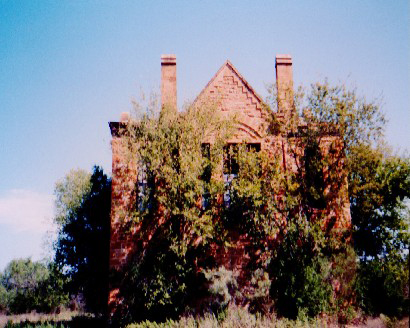

At a site chosen for its low water crossing of the Frio River, Frio City was established in 1871 by A. L. Odin and became the county seat in that same year. The courthouse, the jail – which is still standing – and the post office were completed in 1872. The original courthouse burned in 1877, and a new stone courthouse was constructed with assistance of a local rancher, W. J. Slaughter.
An outpost of civilization, which would occasionally serve as a refuge for people seeking safety from Comanche raids, Frio City is said to have been the site of such notable passersby as Juan Ugalde (Uvalde’s namesake), Santa Anna, and General Woll. Texas Rangers were often called in to solve Indian problems, the last incident of which occurred in 1887. By this time, the estimated population of Frio City was around 1500.
However, by 1890, as a result of the International-Great Northern Railroad having bypassed Frio City, there remained only about 100 people. On the rail line was Pearsall, and people and businesses moved the 16 miles to take advantage of the commerce the railroad provided there. The County Seat was moved to Pearsall in 1883, and the name of Frio City was officially changed to Frio Town in 1886.
Meanwhile, in 1884, the courthouse was purchased by an individual, and it subsequently became a general store and post office for the few remaining residents in the community. By 1953, a Mrs. A. C. Roberts owned most of the town site, which included the former courthouse and jail. She had a keen interest in history, and she contributed what she knew in a 1936 article in Frontier Times called, “Frio County Has a Colorful History.”
Today, the Frio River continues to pass through what was once a prosperous Frio City. The remains of the courthouse, jail, and cemetery are all on private property with only the cemetery having public access. (It can be found on FM 140.) However, in the 1980s, an adventurous couple was allowed to explore the ruins, and their story is documented in Texas Escapes, “Ghost Town Honeymoon,” by Josa Combs.
Josa had surprised her new husband with the request to spend their honeymoon in Frio Town. The couple found the site on an old map at the Frio County Courthouse, and, seeing that it was on the Frio River, they decided to go camping there. Upon searching for the town, they found only corn fields and a gated dirt road. Determinedly, Josa climbed the gate and walked up to “a beautiful old house with a screened-in porch and a man sitting in a rocking chair, reading a book,” she relates. The gentleman, whose name Josa does not recall, welcomed them (she says perhaps because they were on their honeymoon) and permitted the couple to peruse the site.
The gentleman took Josa and her husband to the remains of old Frio Town and told them how to find the jail, cemetery, and old courthouse. He then allowed them to explore on their own. As they then walked through the fields and woods, they glimpsed the old chimneys from the once majestic building and “little grave markers where homes used to be,” Josa wrote. They found the old jail to be in very bad condition, but Josa was intrigued by the marks from inside that former prisoners had carved to track their days. The courthouse she says was massive, and when she “crawled up the steps,” she discovered old papers lying around, a telephone table with all the wires, old benches, and even a judge’s desk. She says, “The huge, beautifully-painted safe was something to see!” And she marveled, “It was almost as if the people had just walked away.”
Josa Combs, who lives in Iowa, kindly shared the story and photographs of her honeymoon trek with Texas Escapes and its readers. Among the photos is one of a Slaughter Tombstone, Slaughter being Josa Combs’ married name.